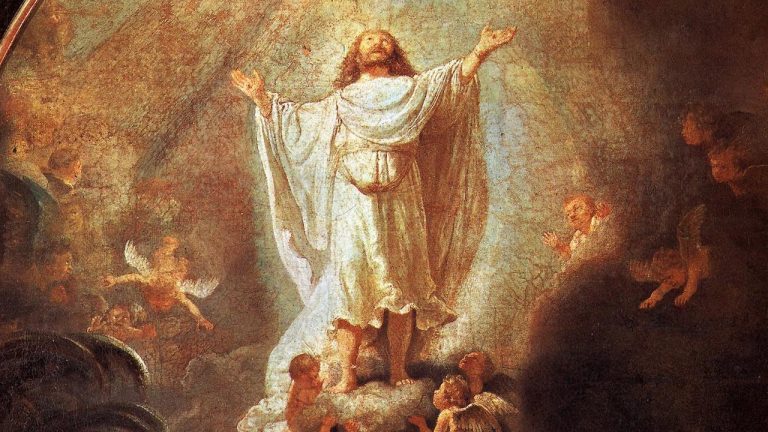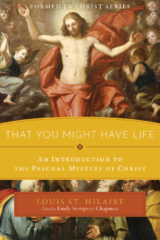By Louis St. Hilaire
Louis St. Hilaire is the author of That You Might Have Life: An Introduction to the Paschal Mystery of Christ and translator of The Literal Exposition of Isaiah: A Commentary by St. Thomas Aquinas (forthcoming from Emmaus Academic). A graduate of Franciscan University of Steubenville, he works as a web developer and digital editor for the St. Paul Center.

Forty days after the Resurrection, the Apostles witnessed the entry of Jesus’ humanity into divine glory as he ascended into the heavens and disappeared into a cloud—a symbol of God’s presence and glory.
The Ascension fulfills Jesus’ words to the chief priests: “you will see the Son of man sitting at the right hand of Power, and coming with the clouds of heaven” (Mark 14:62), and the prophecy of Daniel concerning the Son of Man:
I saw in the night visions, and behold, with the clouds of heaven there came one like a son of man, and he came to the Ancient of Days and was presented before him. And to him was given dominion and glory and kingdom, that all peoples, nations, and languages should serve him; his dominion is an everlasting dominion, which shall not pass away, and his kingdom one that shall not be destroyed. (Dan 7:13–14)
Now, for all eternity, Jesus sits at the right hand of the Father, not only as our king, but also as our high priest. He leads the heavenly worship that honors the Father, and he intercedes for us with the Father: “For Christ has entered, not into a sanctuary made with hands, a copy of the true one, but into heaven itself, now to appear in the presence of God on our behalf ” (Heb 9:24; CCC 662).
Jesus ascended into heaven to begin his reign in glory, but he didn’t abandon us. On the contrary, he said, “I am with you always, to the close of the age” (Matt 28:20). Jesus remains with his Church in many ways. He is present and at work in the sacraments, especially the Eucharist. He is present in the Gospel handed on through Scripture and Tradition. He is present in the successors of the Apostles, who teach and exercise authority in his name. And he is present whenever believers gather in his name, for he says, “For where two or three are gathered in my name, there am I in the midst of them” (Matt 18:20).
Moreover, not only does Jesus remain present to us, but so too does the Holy Spirit, whom, at the Last Supper, he first promised to send to us: “I will ask the Father, and he will give you another Counselor, to be with you forever, even the Spirit of truth” ( John 14:16–17). Later, before ascending to heaven, he told his Apostles to wait for the coming of the Spirit, who would give them power to be his witnesses to the end of the earth (Acts 1:4–5, 8). That promise was fulfilled on the feast of Pentecost, when the Holy Spirit descended upon the Apostles, who were gathered in the Upper Room with the Blessed Virgin Mary (Acts 2:1–42).
On that day, the Apostles were transformed by the power of the Holy Spirit. The same men who had abandoned and denied Jesus during his Passion and then went into hiding out of fear were filled with courage. From the Spirit they received the words to testify to the good news of Jesus’ victory over sin and death throughout the known world. They also received the power to work miracles and the strength to witness to Jesus even to the point of suffering death themselves.
Jesus’ intercession for us in heaven assures us that the Holy Spirit continues to be poured out upon the Church. It is the Holy Spirit who makes Jesus present in the sacraments (CCC 667). It is the Holy Spirit who inspired the Scriptures and who continues to guide the Church in her teaching and preservation of the Deposit of Faith. And it is the Holy Spirit who comes into each one of our hearts, giving us the power to profess faith in Jesus and acknowledge God as our Father: “God has sent the Spirit of his Son into our hearts, crying, ‘Abba! Father!’” (Gal 4:6).
You Might Also Like

The Formed in Christ series is a solid and faithful resource that provides a thorough treatment of the Catholic faith and the various branches of theology. That You Might Have Life: An Introduction to the Paschal Mystery of Christ takes us through creation, the Fall of Man, and Christ’s Paschal Mystery to the reader’s own life and what Christ’s redemption means for us.